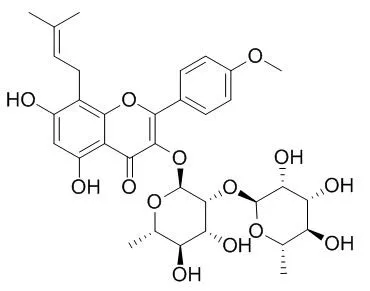| In vitro: |
| Journal of Traditional Medicines, 2007, 24:19-23. | | Inhibitory effect of constituents of Bu-Shen-Jian-Gu-Tang on osteoclast-like cell formation[Reference: WebLink] | The constituents of Bu-Shen-Jian-Gu-Tang and their inhibitory activities on osteoclast-Iike cell formation were investigated. Bu-Shen-Jian-Gu-Tang was fractionated by a Diaion HP-20 column with EtOH-H_2O, and the 60% and 90% EtOH-H_20 fractions showed more potent inhibitory activities on osteoclast-like cell formation and bone resorption.
METHODS AND RESULTS:
Chemical investigation of these two fractions resulted in the isolation of 11 compounds, for which the structures were elucidated based on spectroscopic analysis and chemical reactions. The inhibitory activities of the isolated compounds on osteoclast-like cell formation were evaluated. Among the eleven compounds, icariin (1), icarisid II (2), 2''-O-Rhamnosylicariside II (3), kaempferol (8), chikusetsusaponin IVa (10) and chikusetsusaponin V (11) showed potent inhibitory activities at a concentration of 2 μM without toxic effects.
CONCLUSIONS:
The preventive effect of Bu-Shen-Jian-Gu-Tang on bone loss may be due to the inhibitory activities of these compounds. | | Natural Product Sciences, 2008, 14(4):233-8. | | Flavonol Glycosides with Antioxidant Activity from the Aerial Parts of Epimedium koreanum Nakai[Reference: WebLink] | The aerial parts of Epimedium koreanum Nakai have been used to stimulate hormone secretion in treating impotence.
METHODS AND RESULTS:
Ten flavonol glycosides, 3,4,5-trihydroxy-8-prenylflavone 7-O-[β-D-glucopyranosyl(1 → 2)-β-D-glucopyranoside] (1), hyperoside (2), icarisid II (3), 2''-O-Rhamnosylicariside II (4), epimedin A (5), epimedin B (6), epimedin C (7), icariin (8), hexandraside E (9), and epimedoside A (10) were isolated from the an ethylacetate soluble extracts of the aerial parts of Epimedium koreanum Nakai through activity-monitord fractionation and isolation method. The structures of compounds 1 - 10 were elucidated by high resolution fast atom bombardment mass spectrometry and two dimentional nuclear magnetic resonance spectroscopy analysis.
CONCLUSIONS:
Compounds 1 and 4 showed potent antioxidant activity, with IC50 values of 19.7 and 11.5 μg/mL and 88.2 and 90.5 μM, respectively. |
|






 Cell. 2018 Jan 11;172(1-2):249-261.e12. doi: 10.1016/j.cell.2017.12.019.IF=36.216(2019)
Cell. 2018 Jan 11;172(1-2):249-261.e12. doi: 10.1016/j.cell.2017.12.019.IF=36.216(2019) Cell Metab. 2020 Mar 3;31(3):534-548.e5. doi: 10.1016/j.cmet.2020.01.002.IF=22.415(2019)
Cell Metab. 2020 Mar 3;31(3):534-548.e5. doi: 10.1016/j.cmet.2020.01.002.IF=22.415(2019) Mol Cell. 2017 Nov 16;68(4):673-685.e6. doi: 10.1016/j.molcel.2017.10.022.IF=14.548(2019)
Mol Cell. 2017 Nov 16;68(4):673-685.e6. doi: 10.1016/j.molcel.2017.10.022.IF=14.548(2019)